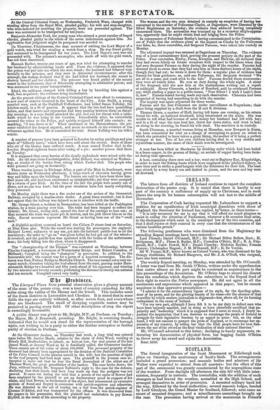SCOTLAND.
The formal inauguration of the Scott Monument at Edinburgh took place on Saturday, the anniversary of Scott's birth. The arrangements included a grand procession; and masonic bodies and admirers of Sir Walter were expected to attend from all quarters: but the effect of this part of the ceremonial was greatly counteracted by the unpropitious state of the weather. From daylight till afternoon the rain fell with little inter- mission, frequently in torrents. The townsfolks, with the addition of such strangers as had braved the weather, assembled at the High School, and arranged themselves in order of procession. Amounted military band led the way, followed by the local authorities; several masonic lodges, headed by Lord Glenlyon, the Grand Master for Scotland, followed; next came an escort of mounted dragoons; and a miscellaneous assemblage brought up the rear. The procession having arrived at the monument in Prince's Street Gardens, and the leading members of it having taken their places on a platform, the ceremony of the day commenced. At a given signal, the covering which concealed the poet's statue was torn away, and the work of art presented to public view. Rounds of cheering, salvoes of artil- lery, and the crash of military bends, welcomed the spectacle. Lord Glenlyon made a congratulatory speech, and handed over the building to the care and keeping of the civic authorities. Mr. Adam Black, the Lord Provost, replied; delivering a lofty panegyric on the genius of Sir Walter Scott, and making complimentary allusions to all who had been engaged in the execution of his architectural monument.
The statue, the uncovering of which constituted the distinotive act of inauguration, is the admired work of Mr. Steele, a native artist ; and re- presents Sir Walter in a sitting posture, with his dog Maids at his feet. The block of marble, in the rough state, weighed from thirty to thirty- three tons-' and its removal from Leghorn to Edinburgh involved a story of remarkable adventures. Four niches immediately over the principal arch are filled by figures of Prince Charles Edward, Meg Menthes, the Last Minstrel, and the Lady of the Lake—all by Edinburgh artists. Mr. George Mickle Kemp, the architect of the Gothic structure, in the lower departments of which the sculpture is placed, was bred an obscure country carpenter, and pushed himself into notice by the force of his abi- lity. When the building was about half finished, he came to an un- timely end by falling, in a dark night, into the Union Canal. The cost of the monument has been from 15,0001. to 16,0001.
The day concluded with a dinner, at the Music Hall, to a very large party; Lord Provost Black in the chair.
There has been good sport on the moors of Perthshire, although not equal to last year's. A sporting friend, whose quarters are at Dalguise, re- ports progress as follows- " We had capital weather on the 12th. Andrew killed his 103 brace of birds, besides a score and a half of hares. Altogether we bagged about 200 brace of grouse, and 60 head of other game. Many covies could not be touched, as they consisted entirely of cheepers, which we spared. I only picked out an old bird now and then. It was killing work for some hours in the forenoon. Last year the birds were two to one as compared with this season; and the conies not so
wild."



























 Previous page
Previous page